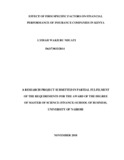| dc.description.abstract | Insurance firms face risks of taking excessive risks that might attract huge insurance losses and increase management expenses in claims investigation, claims payments and monitoring costs. This might impact negatively on operational performance. Therefore, the objective of the research was to determine the effect of firm specific characteristics on financial performance of insurance companies in Kenya. The secondary data used was extracted from the audited IRA annual reports. The study period was five years (2013-2017). Out of the fifty five insurance companies in Kenya, the research managed to get data for thirty companies amounting to 55% response rate. The data was analyzed with the use of SPSS. Descriptive statistics such as means and standard deviations were used to analyze the data while inferential statistics such as correlation and regression analysis were used to test the causal relationship between the dependent and in dependent variables. Financial performance was measured using return on assets. Solvency margin was measured as a ratio of net income to total liabilities. Premium retention was measured as net premium to gross premium. Firm age was done as a log number of years. Financial leverage was measured through debt ratio. Firm size was measured as log total assets while liquidity management was measured through net premium to total liabilities. The study concludes that there is a strong relationship (R= 0.775) between firm specific characteristics and financial performance of insurance companies in Kenya. The independent variables accounted for 60.1% of the total variance in the financial performance of insurance companies. The study also concluded that different factors used affect financial performance of insurance companies differently. There was a strong positive and statistically significant correlation (r = .744, p = .000) between financial performance and solvency margin. The study also revealed the relationship between liquidity management and financial performance was positive but insignificant. There was a negative and insignificant association between (premium retention, firm size) and financial performance. However, the relationship between firm age (r =-225, p =0.006), financial leverage (r =.-200, p = .014) and financial performance was negative and significant. The study recommends that managers of insurance companies in Kenya should therefore consider increasing the solvency margin of their companies in terms of improving efficiency in use of companies’ resource to enhance the net income. | en_US |



